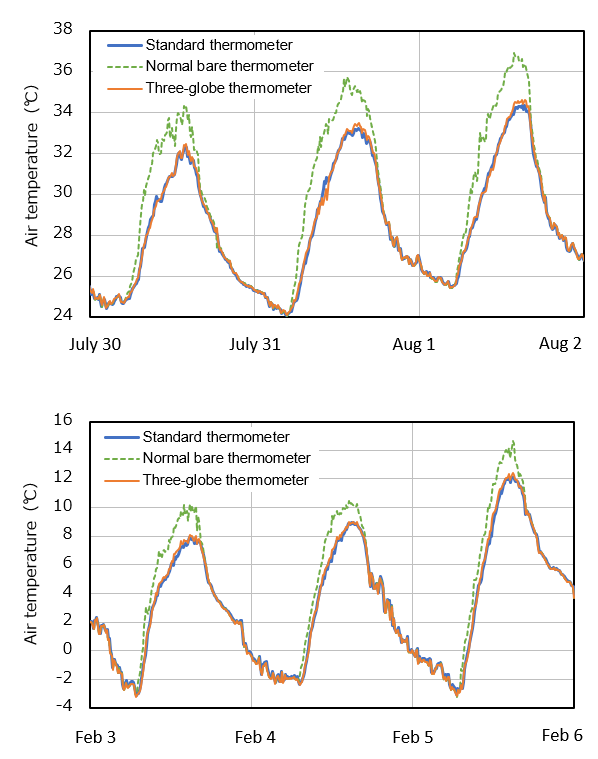The National Agriculture and Food Research Organization (NARO) has developed a new thermometer which does not require a radiation shield or ventilation for field measurement. Obtaining accurate air temperature using the developed thermometer includes a simple calculation process to eliminate the effects of radiation on the measurements. It can be used on farmland and in forests where the mains power is unavailable and is a useful tool to promote the data-driven management of agricultural crops.
Overview
Air temperature is a fundamental element that defines the physical nature of the atmosphere and an important factor that affects the physiology and ecology of many creatures living on the Earth. It is also an important indicator being used in various agricultural practices, from crop production to greenhouse and barn management. With the recent trend of data-driven agriculture, there has been increasing demand for a thermometer that can be easily used outside.
Conventional thermometers for outside use require a radiation shield with ventilation to avoid the impact of solar radiation. When measurements are performed without them due to the limit of space or mains power availability, direct solar radiation will affect the outcome to become higher than the actual value. However, mains power is not always available in rural areas, such as farmlands and forests. There had been a strong demand for a thermometer that can be used in such places.
To solve this problem, NARO has developed a three-globe thermometer which does not require a radiation shield or ventilation. Instead, a simple calculation is used to obtain the proper air temperature by eliminating the effect of solar radiation based on the temperatures of multiple spheres with different sizes. The formula used in the calculation had been derived from heat balance and heat transfer theory for a spherical surface in the external flow. The developer found the optimum combination of the number and sizes of the spheres after a series of field experiments, which are three globes with different diameters of 0.25mm, 1mm, 4mm.
The developed three-globe thermometer has a great advantage for potential users who wants to measure air temperature easily on farmlands and in forests, and there is a high expectation for its effectiveness in the field of data-driven agriculture, as well as in other industries.
Publications
Maruyama, A., Matsumoto, Y., & Nakagawa, H. (2020). Multiple-globe thermometer for measuring the air temperature without an aspirated radiation shield. Agricultural and Forest Meteorology 292, 108028.https://doi.org/10.1016/j.agrformet.2020.108028
For Inquiries
Contact: http://www.naro.affrc.go.jp/english/inquiry/index.html
Reference Information

Fig.1 Relationships between the square root of diameter and the temperature.
The temperature increased with increasing globe diameter and had a consistently linear relationship with the globe size.
Table 1 Variation in the root-mean-square error (RMSE) of air temperature obtained for different numbers of globes and different combinations of globe diameters.
The RMSE shows the accuracy of measurement for each combination. The minimum RMSE was found for three globes with diameters of 0.25, 1, 4 mm (highlighted in gray). The RMSE is shown for data from 6:00 to 18:00 (day), data from 18:00 to 6:00 (Night), and all data (All).


Fig.2 Schematic diagrams of the proposed thermometer: (a) dimensions of globes and pipes; (b) arrangement of three globes with different diameters of 0.25, 1, and 4 mm; (c) photograph of the field experiment site.

Fig.3 Variation in air temperature observed outside using a standard thermometer equipped with a ventilated radiation shield (blue line), normal bare thermometer (green dotted line), and the three-globe thermometer developed in this study (orange line).




